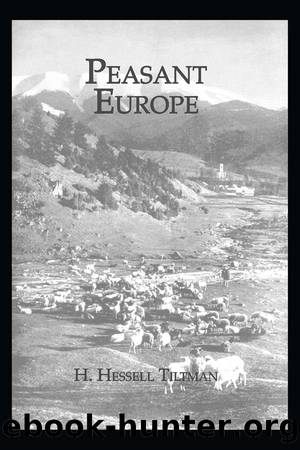Peasant Europe by Hessell Tiltman

Author:Hessell Tiltman [Tiltman, Hessell]
Language: eng
Format: epub
Tags: Social Science, Anthropology, General
ISBN: 9781317845935
Google: 6iGsAgAAQBAJ
Publisher: Routledge
Published: 2014-01-21T04:57:18+00:00
âSONGS OF FREEDOM SUNG WITH NEEDLESâ
A Czech girl working the embroidery for which the peasant lands are famous.
The Bukovina is essentially a peasant land; there are no employed agrarian peasants, although a few in the smallest class, farming an acre or less âon their ownâ, eke out a living by working for the richer farmers. Such workers are paid from 7 1/2d. to 10d. for a day of ten to twelve hoursâwhich is, incidentally, the lowest rate of payment for any employed workers in non-Russian Europe.
In former times the economic mainstay of the peasantry was corn, sugar-beet, and potatoes used in the manufacture of alcohol. Now only two sugar-beet factories are working, and even the drink trade is none too healthy, which may explain why the Czernowitz authorities banned a Ukrainian newspaper, published in the Bukovina, for warning the peasants against drinkâon the ground that, as alcohol is taxed, any propaganda against drink is propaganda against the Rumanian government!
The Bukovina participated, with other Rumanian provinces, in the redistribution of land which followed the war. But whereas in the Regat the Rumanian peasants undoubtedly benefited from that reform, in Bukovina the section of the peasantry of Ukrainian nationality found their claims relegated to the end of the list, after the names of Rumanian officials, doctors, politicians, and others who hastened to take advantage of the âland racketâ which promptly developed. To those non-peasant applicants went most of the land taken over in the Northern Bukovina, and the land-hungry Ukrainian peasantry was left to choose between the alternatives of remaining landless or purchasing smallholdings from the new owners at high pricesâand by means of loans borrowed at 30 to 40 per cent interest. Many chose to buy, for the immediate post-war years were the most prosperous the Bukovina has known for two decades. To-day those same peasants are saddled with mortgages and debts amounting to from £40 to £60 per hectare.
In 1932 the Bukovina produced about 200,000 tons of cereals, including 83,372 tons of maize and 44,304 tons of oats. It was unfortunate for the peasants that the wheat crop of that season was poor, for internal prices rose temporarily owing to a prohibitive import duty, from 1,900 lei per metric ton to 6,000 leiâa reflection of the poor crop. The only effect of this fortuitous âscarcity priceâ, however, was that wheaten flour disappeared, and mamaliga once more become the mainstay of life among the population.
The Bukovina is a land of dwarf farms. Only 1 per cent of its farmers own over 250 acres; 15 per cent of the farms only are in the 60â120 acre class; another 10 per cent own from 25 to 50 acres; while the remaining 75 per cent farm from 2 1/2 to 25 acres. Many of those holdings are the property of Rumanian colonists, transplanted from the Old Kingdom to regions formerly occupied exclusively by members of other races.
Having visited the farms established by âcolonistsâ in Yugoslavia, Bessarabia, and the Bukovina, I had formed the opinion
Download
This site does not store any files on its server. We only index and link to content provided by other sites. Please contact the content providers to delete copyright contents if any and email us, we'll remove relevant links or contents immediately.
De Catalaanse brief by Robert Goddard(317)
A Piece of Cake by Sarah Swatridge(251)
Churchill's Spearhead by John Greenacre(227)
Nonlinear Dynamics and Chaos with Student Solutions Manual by Steven H. Strogatz(219)
The Ruin of J. Robert Oppenheimer by Priscilla J. McMillan(193)
Flowering of the Cumberland by Harriette Simpson Arnow(174)
Popular Culture and Political Identity in the Arab Gulf States by Alanoud Alsharekh Robert Springborg(173)
thing bounces back europe by Unknown(165)
Allied Bombing Raids by Philip Kaplan(163)
A Japanese View of Nature by Kinji Imanishi Pamela J. Asquith(157)
Guild and State by Antony Black(153)
Comet Madness by Richard J. Goodrich(152)
RAF at the Crossroads by Greg Baughen(139)
History Without A Subject by David Ashley(136)
A History of Greek and Roman Philosophy by John Hackney(134)
The Seventies Now: Culture As Surveillance by Stephen Paul Miller(134)
A History of Science in Society by Ede Andrew;Cormack Lesley B.;(131)
Air Battle for Burma by Evans Bryn;(128)
Shocking Bodies by Iwan Rhys Morus(126)
